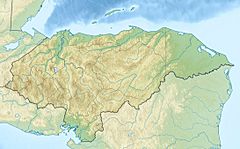Gualcarque River facts for kids
Quick facts for kids Gualcarque River |
|
|---|---|
| Country | Honduras |
| Departments | Intibucá and Santa Bárbara |
| Physical characteristics | |
| Main source | Reserva Biológica Opalaca San Francisco de Opalaca 14°31′N 88°18′W / 14.517°N 88.300°W |
| River mouth | Río Grande de Otoro 14°45′39″N 89°09′45″W / 14.76083°N 89.16250°W |
| Basin features | |
| River system | Ulúa |
The Gualcarque River (Spanish: Río Gualcarque) is a special river located in western Honduras, in the Intibucá area. It is very important to the Lenca, who are an indigenous group living there. They depend on the river for their daily lives.
For many years, there were plans to build a large dam called Agua Zarca on the Gualcarque River. This project was a joint effort between Honduran and Chinese companies. However, the Lenca people felt they were not asked about the project, which led to protests. These protests faced many challenges, and sadly, some people who spoke out were killed. Because of these serious concerns, the companies that were going to fund the dam eventually stopped their support.
Contents
The Gualcarque River and Its Importance
The Gualcarque River starts in the Reserva Biológica Opalaca, a nature reserve in Intibucá. It flows east for about 2.4 miles (3.9 km) before turning north. The river then flows through the Reserva de Vida Silvestre Montaña Verde and finally joins the Río Grande de Otoro.
A Sacred River for the Lenca People
The Lenca people consider the Gualcarque River sacred. This means it is very holy and important to their culture and beliefs. The river provides them with drinking water, fish, and water to irrigate their farm fields. They also use it for washing.
Berta Cáceres, a well-known indigenous activist, explained the Lenca's connection to the river. She said that the Lenca believe they come from the Earth, water, and corn. They see themselves as protectors of the rivers, guided by spirits who teach them that protecting rivers means protecting all of humanity and the planet.
The Agua Zarca Dam Project
Since 2006, a Chinese company called Sinohydro, the World Bank's International Finance Corporation (IFC), and a Honduran company named Desarrollos Energéticos S.A. (DESA) planned to build four hydroelectric dams on the Gualcarque River. One of these was the Agua Zarca Dam.
Community Concerns and Protests
The Lenca people said that the dam project would harm their water supply and their way of life. They were worried because they had not been asked for their permission about the project, which is required by international law.
In 2006, when construction machines arrived, the community members of Río Blanco asked for help from the Council of Popular and Indigenous Organizations of Honduras (COPINH). Together with Berta Cáceres, they held a local meeting where they formally voted against the dam. They also filed complaints with the government and organized protests.
Challenges and Tragic Events
In 2012, DESA began construction on land it had bought. This destroyed corn, bean, fruit, and coffee farms. In March 2013, DESA security officers blocked access to the river. This led the affected communities to start a street blockade.
During these protests, people faced challenges and violence. Sadly, a leader from Río Blanco named Tomas García was shot and killed during a peaceful protest in March 2013.
Later, in March 2016, Berta Cáceres, a leader of the opposition to the dam and an internationally recognized indigenous activist, was also tragically shot and killed in her home.
Project Suspension and Withdrawal
Because of the controversy and human rights concerns, Sinohydro ended its contract with DESA in late 2013. The IFC also withdrew its funding. After Berta Cáceres's death, other funders like FMO and Finnfund suspended their loans.
In 2021, a court ruled that Roberto David Castillo, who was the president of the dam company DESA, had planned Berta Cáceres's murder. By June 2017, all the banks that were financing the project had suspended and withdrawn their funding due to the ongoing controversy.
See also
 In Spanish: Río Gualcarque para niños
In Spanish: Río Gualcarque para niños


